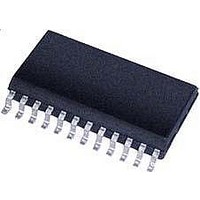CS5460A-BS Cirrus Logic Inc, CS5460A-BS Datasheet - Page 21

CS5460A-BS
Manufacturer Part Number
CS5460A-BS
Description
Driver IC
Manufacturer
Cirrus Logic Inc
Datasheet
1.CS5460A-BSZ.pdf
(54 pages)
Specifications of CS5460A-BS
Peak Reflow Compatible (260 C)
No
Supply Voltage Max
5V
Driver Case Style
SSOP
Leaded Process Compatible
No
Mounting Type
Surface Mount
Package / Case
24-SSOP
Mounting Style
SMD/SMT
Lead Free Status / RoHS Status
Contains lead / RoHS non-compliant
Available stocks
Company
Part Number
Manufacturer
Quantity
Price
Part Number:
CS5460A-BS
Manufacturer:
CIRRUS
Quantity:
20 000
Company:
Part Number:
CS5460A-BSZ
Manufacturer:
CIRRUS
Quantity:
2
Company:
Part Number:
CS5460A-BSZR
Manufacturer:
CIRRUS
Quantity:
8 000
Part Number:
CS5460A-BSZR
Manufacturer:
CIRRUS
Quantity:
20 000
3. FUNCTIONAL DESCRIPTION
3.1 Pulse-Rate Output
As an alternative to reading the real energy
through the serial port, the EOUT and EDIR pins
provide a simple interface with which signed ener-
gy can be accumulated. Each EOUT pulse repre-
sents a predetermined quantity of energy. The
quantity of energy represented in one pulse can be
varied by adjusting the value in the Pulse-Rate
Register. Corresponding pulses on the EDIR out-
put pin signify that the sign of the energy is nega-
tive. Note that these pulses are not influenced by
the value of the Cycle-Count Register, and they
have no reliance on the computation cycle, de-
scribed earlier. With MCLK = 4.096 MHz, K = 1,
the pulses will have an average frequency (in Hz)
equal to the frequency setting in the Pulse Rate
Register when the input signals into the voltage
and current channels cause full-scale readings in
the Instantaneous Voltage and Current Registers.
When MCLK/K is not equal to 4.096 MHz, the
pulse-rate should be scaled by a factor of
4.096 MHz / (MCLK/K) to get the actual output
pulse-rate.
EXAMPLE #1: For a power line with maximum rat-
ed levels of 250 V (RMS) and 20 A (RMS), the
pulse-frequency on the EOUT pin needs to be
‘IR’ = 100 pulses-per-second (100 Hz) when the
RMS-voltage and RMS-current levels on the power
line are 220 V and 15 A respectively. To meet this
requirement, the pulse-rate frequency (‘PR’) in the
Pulse-Rate Register must be set accordingly.
After calibration, the first step to finding the value
of ‘PR’ is to set the voltage and current sensor gain
constants, K
ceptable voltage levels on the CS5460A inputs
when the power line voltage and current levels are
at the maximum values of 250 V and 20 A. K
K
of the voltage/current transformers and/or shunt
resistor values to use in the front-end voltage/cur-
rent sensor networks.
For a sinewave, the largest RMS value that can be
accurately measured (without over-driving the in-
puts) will register ~0.7071 of the maximum DC in-
put level.
perfectly sinusoidal in real-world situations, and to
DS487F4
I
are needed to determine the appropriate ratios
V
Since power signals are often not
and K
I
, such that there will be ac-
V
and
provide for some over-range capability, the RMS
Voltage Register and RMS Current Register is set
to measure 0.6 when the RMS-values of the
line-voltage and line-current levels are 250 V and
20 A. Therefore, when the RMS registers measure
0.6, the voltage level at the inputs will be
0.6 x 250 mV = 150 mV. The sensor gain con-
stants, K
that the voltage and current channel inputs should
be 150 mV RMS when the power line voltage and
current are at the maximum values of 250 V and
20 A.
These sensor gain constants are used to calculate
what the input voltage levels will be on the
CS5460A inputs when the line-voltage and
line-current are 220 V and 15 A. These values are
V
The pulse rate on EOUT will be at ‘PR’ pulses per
second (Hz) when the RMS-levels of voltage/cur-
rent inputs are at 250 mV. When the voltage/cur-
rent inputs are set at V
rate needs to be ‘IR’ = 100 pulses per second. IR
will be some percentage of PR. The percentage is
defined by the ratios of V
V
From this equation the value of ‘PR’ is shown as:.
Therefore the Pulse-Rate Register is set to
~420.875 Hz, or 0x00349C.
The above equation is valid when current channel
is set to x10 gain. If current channel gain is set to
x50, then the equation becomes:
Vnom
Inom
K
K
V
V
PR
PR
/250 mV with the following formula:
V
I
Vnom
Inom
= 150 mV / 20 A = 0.0075 Ω
= 150 mV / 250 V = 0.0006
and V
=
=
PulseRate
---------------------------------------- -
----------------- -
250mV
V
------------------------------------------- -
----------------- -
250mV
V
V
= K
= K
Vnom
Vnom
and K
Inom.
I
V
IR
* 15 A = 112.5 mV
IR
×
×
* 220 V = 132 mV
-------------- -
50mV
----------------- -
250mV
V
I
V
, are determined by demanding
=
Inom
Inom
IR
=
Vnom
=
PR
----------------------------------------------- -
132mV
----------------- -
250mV
⋅
------------------ -
250mV
V
and V
Vnom
100Hz
Vnom
×
112.5mV
---------------------- -
250mV
Inom
⋅
CS5460A
/250 mV and
------------------ -
250mV
V
Inom
, the pulse
21



















